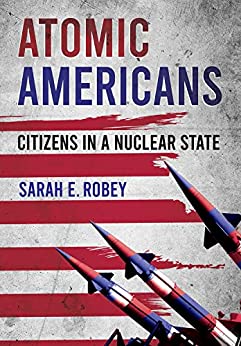The Book
Atomic Americans: Citizens in a Nuclear State
The Author(s)
Sarah E. Robey

Robey’s careful study examines the first decades after Hiroshima to explore changes in relations between the US state and citizens living in the shadow of a potential nuclear war. Her primary focus is civil defense, presented as a complex assemblage of objects (backyard shelters), discourses (national security, popular dissent), dominant ideologies (self-help, “peace,” scientific authority), bureaucratic structures (White House, Defense Department, federal emergency management agencies) and global events (Sputnik, Pacific testing, Cuba). Her argument is two-fold: first, that during the Cold War the US government steadily reduced its commitment to building a universal system of protection against nuclear attack, ending up placing the ultimate responsibility for survival on individual families; and second, that as a result, and further complicated by the ambivalent character of nuclear power, American citizens gradually lost faith in and expected increasingly less from their government as a provider of the most basic of public goods (“civic disenchantment”), prefiguring the decline in state legitimacy that is all too apparent today. For the federal government, Robey argues, survival became both task and proof of good citizenship.
The materials presented in the book run from 1945 until the Limited (or Partial) Test Ban Treaty of the early 1960s. Individual chapters offer both historical coverage of the debates and decisions of the 1950s as well as thematic discussions of, for example, the changing role of scientific authority and the importance of fallout. Fallout – the invisible sign of a nuclear world – is particularly identified as creating psychic fears in a population that was increasingly aware of but unable to cope with the existential threat of a nuclear holocaust. Building on the foundational work of historians Laura McEnaney, Jessica Wang, Toshihiro Higushi and others, Robey draws on an extensive archive of correspondence with elected officials as one of her primary sources. There is a close reading of the primary government reports defining the meanings and parameters of civil defense, each proposing a different set of responsibilities for the state and the individual. Additional analytic threads running through the volume include the contradictions of official secrecy and the dilemmas thrown up by nuclear ambivalence. These discussions offer connections to the nuclear studies literature more generally, opening up the work beyond the frame offered by American Studies.
As with most historical studies, explicitly theoretical engagements are relatively few. This is a pity because Atomic Americans is also a case study in the making of a population, in the sense used by Michel Foucault, referring to a collective that is defined through biopolitics rather than liberal political theory. As decision makers discussed how many Americans might survive a nuclear war (and by extension how many and what kind of survivors were needed to revive the country again), we see the idea of the American people shifting from a culturally and racially defined entity to a society that is defined through biopolitical criteria. Social unease at the idea of citizenship defined through biopolitics is captured by another term that recurs more than once, ambivalence. Robey prefers to use the term ambiguity in her initial chapters, while turning to ambivalence in the latter portion of the book.
Ambivalence, or the attribution of multiple and even contradictory meanings simultaneously, is a vital tool to understand nuclear power. Nuclear power is inherently ambivalent – whether expressed through the familiar idea of a “dual use” technology or in its dominant representation as simultaneously a political weapon and a military weapon. Robey’s discussion of secrecy is a case in point. When information about nuclear weapons was hoarded as the ultimate state secret, decision-makers came to realize that effective civil defense was impossible unless the population knew more about nuclear weapons and their effects. Yet the more the population came to know, the less they had faith in their government’s ability to protect them from its already-present effects, not least fallout.
The book is well written and clearly argued. It adds to our knowledge of popular engagements with nuclear power during the early Cold War and tracks carefully the shifting meanings and growing complexity of what civil defense came to mean at multiple scales. Atomic Americans can be used productively as a supplemental text in senior undergraduate classes and graduate courses on the Cold War as it was experienced in the United States.
About the Reviewer
Bio: Itty Abraham is a nuclear historian and professor in the School for the Future of Innovation in Society at Arizona State University, Tempe.

0